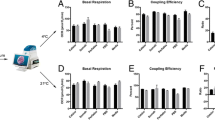Abstract
Cell transplantation is becoming an important technique for treatment of heart failure. Preservation is an integral step in any procedure using cells. There are two primary modes of cell preservation at low temperature, hypothermic preservation at temperatures above freezing and cryogenic preservation at temperatures below freezing. Optimal preservation protocols require a fundamental understanding of the principles involved. This review briefly describes the basic mechanisms of damage during hypothermic and cryogenic preservation and the basic principles for developing optimal protocols for preservation of cells.
Similar content being viewed by others
References
Zieger MAJ, et al. Factors influencing survival of mammalian cells exposed to hypothermia. Cryobiology 1990;27:452-464.
Morris GJ, Clarke A eds. The Effects of Low Temperature on Biological Membranes. London, Academic Press, 1981.
Quinn PJ. A lipid phase separation model of low temperature damage to biological membranes. Cryobiology 1985;22:128-147.
Wolfe J, Bryant G. Drying and/or vitrification of membranesolute-water system. Cryobiology 1999;39:103-130.
Grout BWW, Morris GJ eds. The Effect of Low Temperature on Biological Systems. London, Edward Arnold Ltd., 1987.
Belzer FO, Southard JH. Principles of solid organ preservation by cold storage. Transplantation 1988;45:673-676.
Michel P, et al. A comparative study of the most widely used solutions for cardiac graft preservation during hypothermia. Journal of Heart & Lung Transplantation 2002;21(9):1030-1039.
Singer MA, Lindquist S. Thermotolerance in Saccharomyces cerevisiae: The yin and yang trehalose. Trends in Biotechnology 1998;16:460-468.
Rubinsky B, Arav A, Fletcher GL. Hypothermic protection-A fundamental property of antifreeze proteins. Biochem Biophys Res Comm 1991;180:566-571.
Franks F, et al. Ice nucleation and freezing in undercooled cells. Cryobiology 1983;20:44-63.
Franks F ed. Water: A Comprehensive Treatise. New York: Plenum Press, 1982.
Rubinsky B. Solidification Processes in Saline Solutions. J of Crystal Growth 1983;62:513-522.
Kurtz W, Fisher D, J. Fundamentals of Solidification. Switzerland: Trans Tech SA, 1984;242.
Rubinsky B, Ikeda M. A cryomicroscope using directional solidification for the controlled freezing of biological material. Cryobiology 1985;22:56-68.
Diller KR. Cryomicroscopy. In: McGrath J, Diller KR, eds. Low Temperature Biotechnology: Emerging Applications and Engineering Contributions. New York: ASME: 1988:347-363.
Ishiguro H, Rubinsky B. Mechanical interactions between ice crystals and red blood cells during directional solidifi-cation. Cryobiology 1994;31:483-500.
Lovelock JE. The haemolysis of human red blood cells by freezing and thawing. Biochem Biophys Acta 1953;10:412-426.
Mazur P. Cryobiology: The freezing of biological systems. Science 1970;68:939-949.
Tatsutani K, et al. The effect of thermal variables on frozen human prostatic adenocarcinoma cells. Urology 1996;48(3):441-447.
Merryman HT. Cryobiology. New York: Academic Press, 1966:966.
Tatsutani K, Rubinsky B. A method to study intracellular ice nucleation. J of Biomech Eng ASME Trans 1998;120(1):27-31.
Diller KR, Cravalho E, G. A cryomicroscope for the study of freezing and thawing processes in biological cells. Cryobiology 1970:7:191-199.
Toner M, Cravalho E, G, Karel M. Thermodynamics and kinetics of intracellular ice formation during freezing of biological cells. J Appl Phys 1990:69:1582-1593.
Nei T. Mechanism of hemolysis by freezing at near zero temperatures. II investigation of factors affecting hemolysis by freezing. Cryobiology 1967;4:303-308.
Wolfe J, Bryant G. Cellular cryobiology-Thermodynamic and mechanical effects. Int J Refrig 2001;24:438-450.
Forsyth M, MacFarlane D, R. Recrystalization revisited. Cryo-Letters 1986;7:367-378.
Rubinsky B, Cravalho E, G. Analysis for the temperature Distribution During the Thawing of a Frozen Biological Organ. AIChE Symposium Series 1979;75:81-88.
Baust JM, Van Buskirk R, Baust J, G. Cell viability improves following inhibition of cryopreservation-induced apoptosis. In Vitro Cellular & Developmental Biology Animal 2000;36(4):262-270.
Prehoda RW. Suspended Animation. Philadelphia, New York, London: Chilton Book Co., 1969:211.
Polge S, A Smith V, Parkes A. Revival of spermatozoa after vitrification and dehydration at low temperature. Nature 1949;164:666.
Lovelock JE, Bishop M, WH. Prevention of freezing damage to living cells by dimethyl sulfoxide. Nature 1959;183:1394-1395.
Hobbs KEF, Huggins C, E. Investigation of the effect of cryophylactic agents on the isolated rat heart at 37? C. Cryobiology 1969:6(3):239-245.
Rubinsky B, Pegg D, E. Amathematical model for the freezing process in biological tissue. Proc of the Royal Society 1988;234:343-358.
Rall W, Fahy G. Ice free cryopreservation of mouse embryos at minus 196 Celsius by vitrification. Nature 1985;313(6003):573-575.
Author information
Authors and Affiliations
Corresponding author
Rights and permissions
About this article
Cite this article
Rubinsky, B. Principles of Low Temperature Cell Preservation. Heart Fail Rev 8, 277–284 (2003). https://doi.org/10.1023/A:1024734003814
Issue Date:
DOI: https://doi.org/10.1023/A:1024734003814




